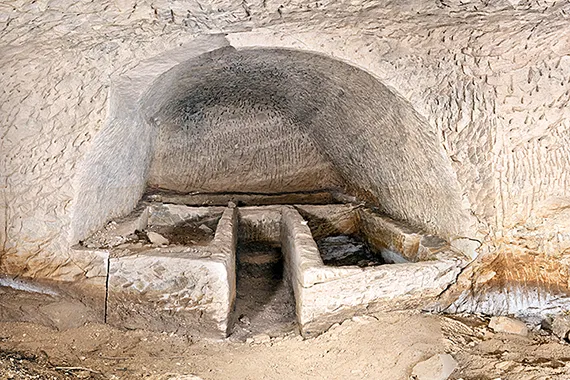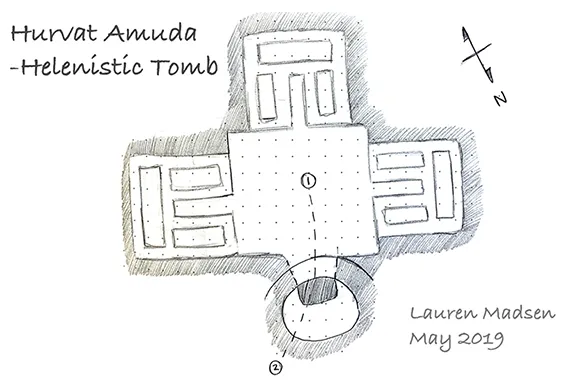
Hellenistic Tomb
This Hellenistic Burial Cave is located in the Hurvat Amuda region of the larger Beit Lehi Regional Project along the northern edge of a terraced field. It is currently accessed using a ladder until a full excavation can be made. It features a small opening into a larger courtyard. Branching off the main courtyard are three corridors each one has a place to burry three bodies. This tomb was looted many years ago and when we found it, there were no bodies found.
Video
Video Transcript
So here we are in the Hellenistic burial cave probably from the 3rd or 2nd century BCE. Very small entrance to a main courtyard that led into three areas of burial on each area there’s like three burials, which means this is a family tomb. You can see one here, one here, and one here and a service corridor to take care of the bodies.
Of course, the burials were covered with stone slabs, big stone slabs so they were not open like there today. It’s a characterized Hellenistic burial cave where you have this small entrance into the courtyard and then some burials on the sides it’s quite large as you can see they were covered with stone slabs and the way it was cut the vaults it had big profiles cut or categorized to the Hellenistic period. There’re three burials on each side which means this family tomb had like nine but it’s but sometimes you have more than one skeleton in in one tomb so perhaps even more.
Burial caves are always interesting because you dealing hear with people, with dead people, sometimes we find some interesting stuff in burial caves unfortunately this burial cave was looted, we don’t know when, but probably many years ago. Still there’s a chance to find some coins or some pottery or even glass vessels that they used inside the burial caves. But when you find the burial cave that was not looted, this is a big celebration because together with the human remains you find many small finds from the type of the burial. They could be coins glass vessels a pottery, complete pottery, that they used for perfume to have some better smell inside the burial. So it’s almost are always fun to find the burial. Since most of the remains above ground here from the Hellenistic period we stand that we’re gonna find more pearls in the future hopefully even ones that were not looted.
In the 120 last years of the Second Temple period, the burial custom in Judaism changed, has been changed, because of the idea of the resurrection they figured out that they don’t want to gather all the bones together like they did in the first Temple period and early Second Temple period. If you know the phrase “gathering to his ancestors” comes from this habit from this barrier system that he put the dead body on a shelf and few years later when someone else in the family died you come in and you gather the latest bones into one big pile and you put the new body on the shelf and this is how it works.
In the last 120 years of the Second Temple period with the idea of the resurrection they figured out that they don’t want me to walk with –after the resurrection– that the bones will be mixed and I will walk with your leg and you will use my hand and etc. so they started to separate the burials. They called it secondary burial, we call the second secondary burial system. What is secondary burial system? Same idea, you put the body on a shelf but after 11 or 12 months after the meat was decomposed you are coming and you collect the bones and put it in ossuaries, ossuary is the Greek word for box. The box can be formed stone, can be from lead, can be from wood. We didn’t find any wood ossuaries but we found the nails that were placed in on the right location. Then you take the ossuary and you put it in a niche at the end of the burial.
After the destruction of the second temple, the idea of the resurrection was lost in Judaism and we returned into first burial system again until today.
Virtual Tour
The virtual tour for this location works on your computer web browser as well as a tablet or a phone. Best of all, it works on your headset. For instructions using an Oculus Quest, please see our virtual visit page.
Image Gallery



